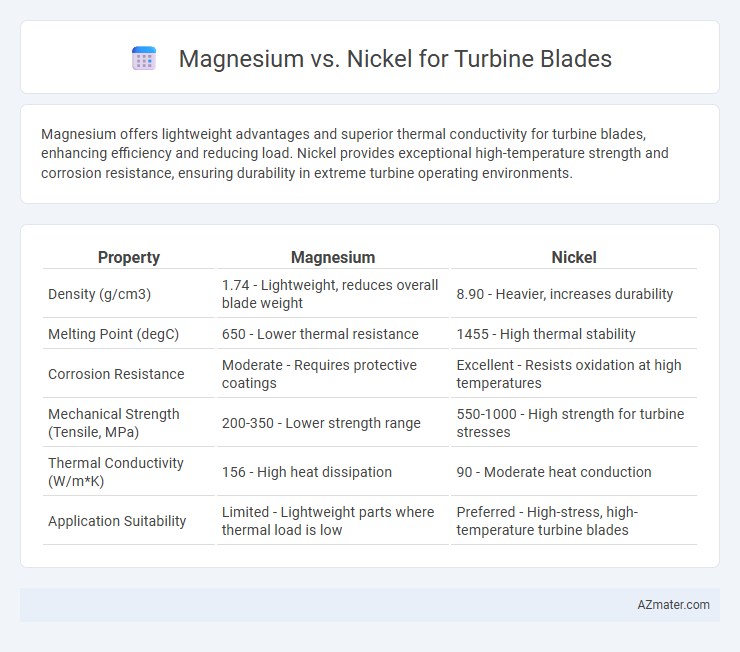Magnesium offers lightweight advantages and superior thermal conductivity for turbine blades, enhancing efficiency and reducing load. Nickel provides exceptional high-temperature strength and corrosion resistance, ensuring durability in extreme turbine operating environments.
Table of Comparison
| Property | Magnesium | Nickel |
|---|---|---|
| Density (g/cm3) | 1.74 - Lightweight, reduces overall blade weight | 8.90 - Heavier, increases durability |
| Melting Point (degC) | 650 - Lower thermal resistance | 1455 - High thermal stability |
| Corrosion Resistance | Moderate - Requires protective coatings | Excellent - Resists oxidation at high temperatures |
| Mechanical Strength (Tensile, MPa) | 200-350 - Lower strength range | 550-1000 - High strength for turbine stresses |
| Thermal Conductivity (W/m*K) | 156 - High heat dissipation | 90 - Moderate heat conduction |
| Application Suitability | Limited - Lightweight parts where thermal load is low | Preferred - High-stress, high-temperature turbine blades |
Introduction to Turbine Blade Materials
Turbine blades require materials with exceptional strength, corrosion resistance, and high-temperature stability, making nickel alloys the industry standard due to their superior mechanical properties and ability to withstand extreme operating conditions. Magnesium, while lighter and offering excellent corrosion resistance in some environments, lacks the high-temperature strength and creep resistance necessary for turbine blade applications. Advanced nickel-based superalloys are engineered for durability and performance, ensuring turbine efficiency and longevity in aerospace and industrial engines.
Material Properties: Magnesium vs Nickel
Magnesium offers a low density of approximately 1.74 g/cm3, providing significant weight reduction benefits for turbine blades, but it has lower melting points (around 650degC) and reduced corrosion resistance compared to nickel. Nickel alloys, with densities near 8.9 g/cm3, possess superior high-temperature strength, melting points exceeding 1400degC, and exceptional oxidation resistance essential for turbine blade durability in extreme thermal environments. The high creep resistance and corrosion tolerance of nickel alloys make them the preferred choice for turbine blades requiring long-term operational stability at elevated temperatures.
Weight Considerations in Turbine Blades
Magnesium alloy turbine blades offer significant weight reduction compared to traditional nickel-based blades, with magnesium being approximately 60% lighter than nickel. This lower density contributes to improved turbine efficiency and reduced centrifugal stress, enhancing overall performance and lifespan. However, magnesium's lower melting point and reduced mechanical strength must be carefully managed through advanced coatings and alloying to ensure durability under high-temperature turbine conditions.
Strength and Durability Comparison
Nickel alloys outperform magnesium in turbine blade applications due to superior strength and high-temperature durability, maintaining mechanical integrity at temperatures exceeding 1000degC. Magnesium's lower density offers weight savings but suffers from reduced corrosion resistance and lower fatigue strength under thermal cycling conditions. Consequently, nickel-based superalloys are preferred for critical turbine components requiring exceptional strength, creep resistance, and oxidation stability.
Corrosion and Oxidation Resistance
Nickel alloys exhibit superior corrosion and oxidation resistance compared to magnesium, making them the preferred choice for turbine blade applications exposed to high-temperature environments. Magnesium's lower oxidation resistance limits its durability under oxidative stress, leading to faster degradation and reduced service life. The high chromium and aluminum content in nickel-based superalloys significantly enhances their protective oxide layer, ensuring prolonged performance in harsh turbine conditions.
Thermal Performance in High-Temperature Environments
Magnesium alloys exhibit lower thermal conductivity and melting points compared to nickel-based superalloys, limiting their effectiveness in high-temperature turbine blade applications. Nickel superalloys possess exceptional thermal stability, oxidation resistance, and creep resistance at temperatures exceeding 800degC, making them ideal for turbine blades operating in extreme thermal environments. The superior phase stability and high melting point of nickel alloys ensure reliable thermal performance and structural integrity in advanced gas turbine engines.
Manufacturing and Machinability
Magnesium offers excellent machinability for turbine blade manufacturing due to its low density and ease of cutting, which reduces tool wear and machining time compared to nickel. Nickel alloys provide superior high-temperature strength and corrosion resistance but require advanced machining techniques such as electro-discharge machining (EDM) to handle their toughness and harder microstructure. Manufacturing turbine blades from magnesium demands strict control over oxidation and flammability risks, whereas nickel blades benefit from well-established casting and forging processes optimized for aerospace applications.
Cost Analysis: Magnesium vs Nickel
Magnesium offers a significantly lower material cost compared to nickel, making it an economical choice for turbine blade manufacturing in cost-sensitive applications. Nickel's higher price is attributed to its superior corrosion resistance and high-temperature strength, which justify its expense in high-performance turbines. Evaluating lifecycle costs reveals that although magnesium reduces upfront expenses, nickel's durability can lead to lower maintenance and replacement costs over time.
Environmental and Sustainability Factors
Magnesium turbine blades offer advantages in sustainability due to their lower density and energy-efficient recycling processes, resulting in reduced carbon emissions compared to nickel. Nickel, while providing superior high-temperature strength and corrosion resistance, involves more energy-intensive mining and refining operations, contributing to greater environmental impact. Choosing magnesium over nickel can significantly decrease the turbine's overall environmental footprint but requires consideration of material performance under operational stress.
Future Trends in Turbine Blade Material Selection
Future trends in turbine blade material selection emphasize the shift from traditional nickel-based superalloys to novel magnesium alloys due to magnesium's superior weight reduction and thermal conductivity. Advanced manufacturing techniques, such as additive manufacturing, are enhancing the performance and microstructural control of magnesium-titanium composites, promising increased efficiency and durability in high-temperature turbine environments. Research continues to focus on overcoming magnesium's lower melting point and corrosion resistance compared to nickel to unlock its full potential in next-generation turbine blades.

Infographic: Magnesium vs Nickel for Turbine Blade
 azmater.com
azmater.com